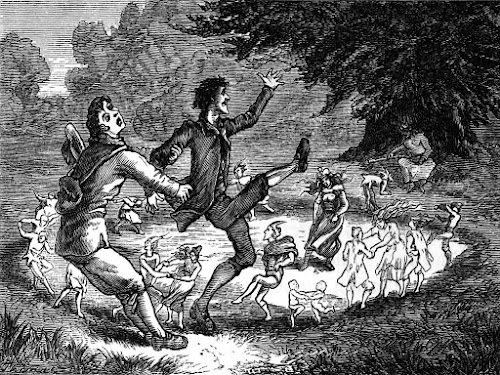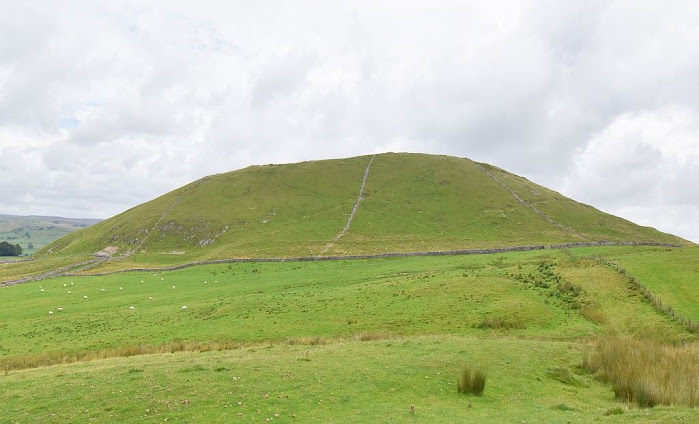"From Burnsall's tower the midnight hour
Had tolled, and its
echo was still.
And the elfin band, from faerie land.
Was upon
Elbolton hill."
(Dixon 1827)
Elbolton is the name of a large dome shaped hill, 2 miles to the south of Grassington, in the Yorkshire Dales.
Elbolton is the largest in a group of conspicuous hills located between the river Wharfe and the higher moorland of Rylstone Fell. These hills are referred to as the Cracoe Reef Knolls, as they are limestone outcrops that once formed part of an ancient sea bed. In the folklore of this region, Elbolton was regarded as the chief dwelling place of the fairy folk, and in more recent times archaeologists have found a group of Bronze Age burials in a cave on the east side of the hill.
Once again it seems that James Henry Dixon provides the first reference to the Elbolton fairies, when he contributed an article to Hone's Table Book, published in 1827. Dixon noted that ...
"Elboton is the largest of five or six very romantic green hills, that seem to have been formed by some tremendous convulsion of nature, at the foot of that fine chain of fells, which extends from Rylstone to Burnsall, and is said to have been, from "time where-of the memory of man runneth not to the contrary," the haunt of faeries;" and "Beneath the upper range of fells, are several round green hills, the largest of which is Elboton, so famed in the fairy lore of the district".
In the early 1800's the name of the hill appears to have been pronounced
Elboton or Helboten, and Dixon refers to 'Halig boden' meaning holy ground. He
also quotes Dr. Whitaker's suggestion that the name meant the 'Fairies
mansion' (elf ground). This would tally with 'Bolton' meaning a settlement or
dwelling, and elbe/aelf as old forms of the word 'Elf'. ie. The Elf
Dwelling.
The above story shows that by the early 1800's the popular belief in fairies had shrunk them down to 'pocket sized', where as in older stories the faerie folk are described as just being short or indistinguishable from normal humans. The story also seems to contain a nod towards the folklore theme of stealing from the fairies. In general it seems that by this time, the once real and genuine belief in fairies had dwindled to just a few tall tales to account for someone being late home from the pub, or any tumbles along the way.
In the early 1900's, Halliwell Sutcliffe recorded another piece of the Elbolton fairy lore in The Striding Dales (Sutcliffe 1929). A man called Daniel wadilove had spoken ill of the Elbolton fairies, and so their Queen decided to teach him a lesson. One night as he was passing the hill, an enchantment fell upon him and he lost his way. He saw a light shining in the distance, and thinking it was a house or another person carrying a lamp, he set off towards it. But this was no mortal flame, this was a 'Corpsie' or spirit light, which led him even more astray. For hours he tripped and stumbled around the hill, while the air around him was filled with howls and screams, and all the while he felt himself nipped and punched by invisible hands. Finally the light led him to the fairy Queen herself, where he fell to the ground and begged her forgiveness. She accepted his apology, and kissing her hand, he promised never to disrespect the fairy folk ever again.
Although the fairy tradition was fading even during Dixon's day, he does includes some other elements of the old fairy belief in the area.....
"The Craven fairies consist of two classes, the good and bad, or rather the mischievous. The former are those who on moonlight nights frequent green hills and pastures, and dance to sweet music breathed from reeds and oaten pipes. They are small graceful creatures, and subject to a king and queen—democracy being unknown in the fairy world. They are fond of appropriate gifts, but invariably resent improper or unseemly ones."
This is interesting as it suggests that gifts or offering were left for
the fairies at one time. He also adds the common belief that the fairies would
steal children, leaving a fairy changeling in their place. He mentions that he
knew of a very small women in Grassington who was locally believed to be a
changeling. Another interesting comment from Dixon is that the Fairies were
generally referred to as the Green Folk ....
" Therefore, we will leave the green hill in the quiet possession of the “green folk,” as Craveners were wont to call them."
This may have a wider relevance to place names such as the Green Well at Timble and perhaps even Greenhow Hill near Pateley Bridge. Dixon's 'green hills' refer to the Cracoe reef knolls, which being composed of limestone, make the soil more fertile, and so the grass on the hills is actually greener than the surrounding moorland. This curious effect would have supported the more general association of the colour green with the fairies.

|
|
Fairy Rings on Elbolton Hill |
On a visit to Elbolton in August 2021, it should perhaps have been no surprise to see a group of dark green circles and arcs in the grass on the southern slopes of the hill. These 'Fairy Rings' are created by the root system of fungi, and mushrooms can sometimes be found growing in the circles. As the name suggests, old folklore records that Fairy Rings are created where fairies dance, their tread making the grass grow more lush and green. Although Dixon does not mention Fairy Rings, he does note the local belief that mushrooms were made by the Fairy folk, and in one case they were seen as a gift from the fairies to those who respected them.
All these ideas and bits of folklore seem to be remnants of a very old beliefs, probably dating back to the pre-Christian era. A time when spirits were connected with the fertility of the land, livestock and people. One of the more convincing theories regarding the origins of Fairy belief is that they were originally regarded as ancestral spirits. The once widespread tradition of burying the dead in burial mounds would also explain why later folklore records the fairies as living within such mounds.
Elbolton - Hill of the Dead

|
|
Knave Knoll Hole - cave entrance |
It cannot have escaped our distant ancestors that Elbolton Hill looks
like a giant sized burial mound, and this observation is supported by a group
of ancient burials being found within a cave on the hill.
This cave is marked on the modern OS map with the curious name of Navvy
Noddle Hole, which perhaps shows how the original map surveyors struggled with
the dales accent. Earlier writers called the cave Knave Knoll Hole, suggesting
that Elbolton hill was also known as Knave Knoll. In his History of Craven, Dr
Whitaker noted that he explored this cave in the late 1700's .......
"In a pasture above this village is a cave, called Knave Knoll Hole, very difficult of access, and, from the narrowness of the entrance, equally difficult to be discovered. For these reasons it seems to have been a retreat of some ancient banditti. On descending into it several years ago, I discovered, besides many bones of sheep, &c. the remains of an human skeleton."

|
|
Looking down into the cave |
Almost 100 years later in 1888, the cave was excavated and the
remains of at least 11 people were found, some buried in simple stone kists
below the floor of the cave. The pottery found with the bones dated these
burials to the early Bronze Age, over 3000 years ago. (Jones, 1889). The cave
entrance is located beneath a limestone out crop near the top of the hill on
its east side. The opening drops vertically for over 20 feet to the floor of
the main chamber. From there a second passage descends further underground,
and connects to other caves within the hill, but this now requires passing
under a flooded 'sump' to access them. The upper entrance to the cave was
apparently enlarged to allow better access during the excavation, with the
original being a narrow crevice as described by Dr Whitaker. A metal grill now
covers the entrance to prevent sheep falling down.
Dixon briefly mentions Knave Knoll Cave in his ballad of Trollers Gill...
The Troller, I ween, was a fearless wight
And, as legends tell,
could hear
The night winds rave, in the Knave Knoll cave,
Without
a sign of fear.
Although no further details exist, this verse suggests a local tradition
that the cave was a place to be feared, and only the very brave would spend
the night there. The 'night winds rave' perhaps indicates that the shape of
the chamber, or the wind blowing across the narrow entrance, produced a
frightening noise of some kind.
The Knave Knoll Hole name suggested a bandit or robber's hideout to Dr Whitaker, with the dictionary describing a Knave as a "tricky, deceitful fellow; a dishonest person". Could this also be a reference to the mischievous fairy folk connected with the hill?
Alternatively, given the shape of the hill, 'nave' is an old word meaning the hub of a wheel or a shield boss - both raised and rounded features like the hill. This hub or central meaning could also have a wider significance, as from the top of the hill there is an impressive 360 panoramic view of the region. Given the nave name, plus the shape of the hill, the folklore, and the view from the summit, it is possible to speculate that in the distant past, Elbolton may have been regarded as a local 'omphalos' or centre of the district. Omphalos is a Greek word for the hub or centre of something, and also the belly button or navel - a word derived from the same root as nave.
When viewed from the cave entrance at certain times of the year, the sun would be seen rising over the impressive crags of Simon's Seat on the horizon to the east. The rising sun as a symbol of new life may seem at odds with a burial mound shaped hill and actual cave burials, but as those bodies were carefully lowered down the narrow crevice into the womb-like cave below, and buried there in the foetal position, perhaps the gently swelling 'bump' of the hill also represented the promise of new life or rebirth within the mother earth?
The remains of those Bronze Age ancestors lay within the cave for over a thousand years, their spirits perhaps being regarded as guardians over the hill and surrounding district. Each year they were 'reborn' with the sunrise over the crags of Simon's Seat, and for those who had the 'gift', they could still be seen on moonlit nights performing their ancient dance upon the hill.
References
Dixon, J.H. (1827) Hone's Table Book.
Dixon,
J.H. (1881) Chronicles and Stories of the Craven Dales.
Halliwell
Sutcliffe, H.J. (1929) The Striding Dale
Jones, E
(1889) Exploration of Elbolton Cave - Proc. Yorkshire Geological Society
Whitaker,
T.D. (1805)
History and Antiquities of the Deanery of Craven.






Post a Comment